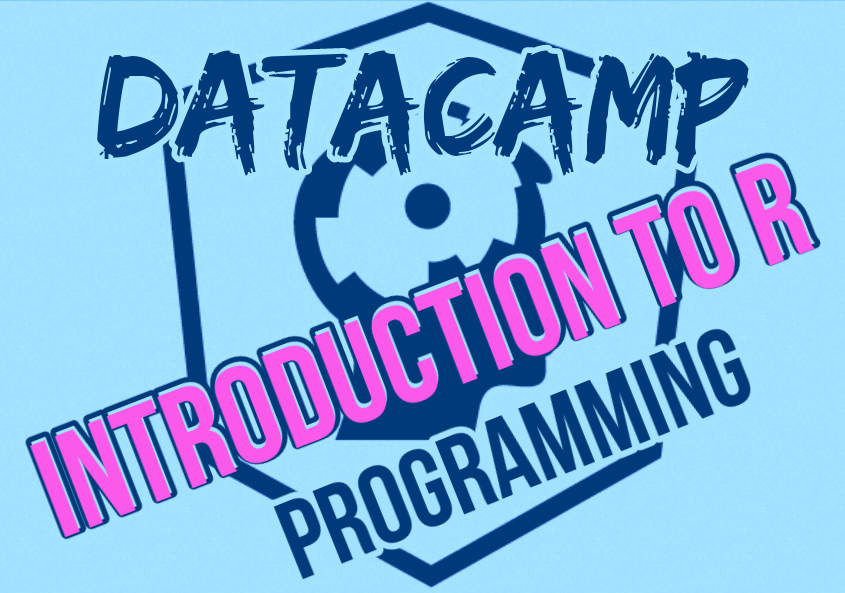Table of Contents
R programming is a big undertaking.
I mean how do you get from this…
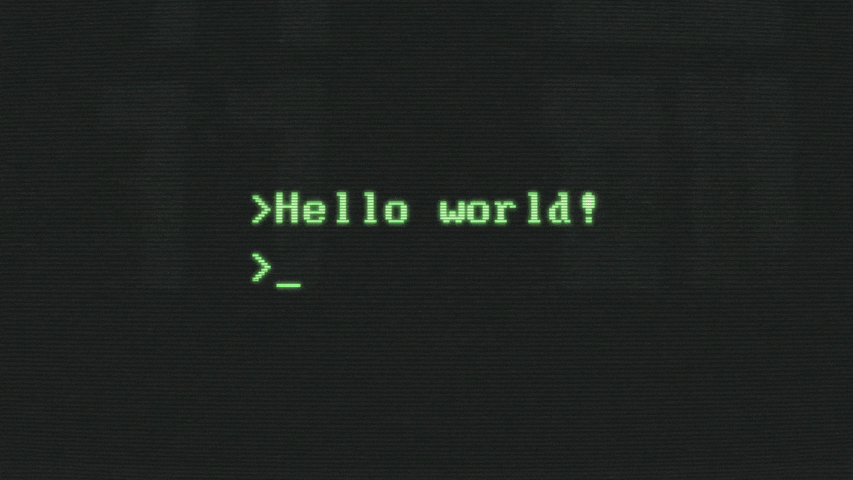
… To this?
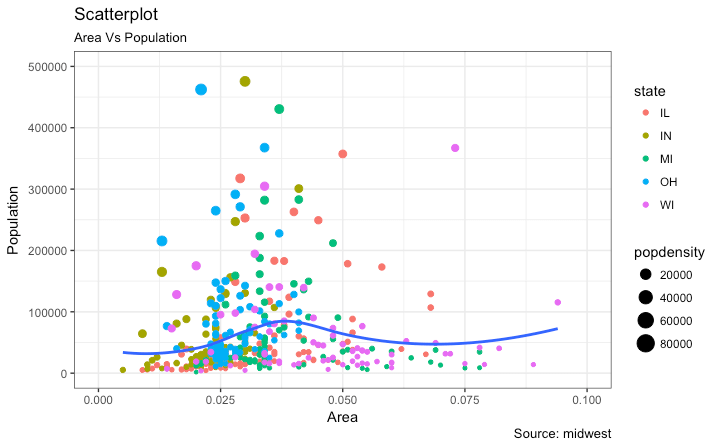
Not to worry.
We’ve found an awesome introduction to R programming.
But first…
🧐 What is R?
R is a programming language for statistical computing and graphics.
It’s one of the most popular languages used by statisticians, data analysts, researchers and marketers.
Introduction to R Programming: What are some uses of R?
R is used to to retrieve, clean, analyze, visualize and present data.
It’s applied to diverse fields such as:
- social media – behavior analysis
- IT – software development
- finance – fraud detection
- government – record-keeping
And much, much more.
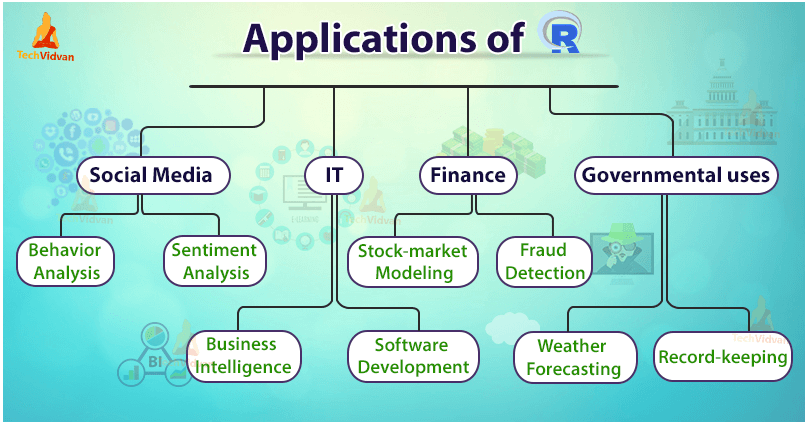
Best way to learn R:
In our opinion, one of the best ways to learn R is taking online courses.
And that’s why we recommend DataCamp.
This post contains affiliate links. I may receive compensation if you buy something. Read my disclosure for more details.
Introduction to R Programming – TLDR:
➡️ 146 R courses
➡️ 80 projects
➡️ 23 skill tracks for R
➡️ 6 career tracks for R
Sign up for DataCamp’s Introduction to R
👉 here. 👈
What is DataCamp?
DataCamp is a text and video-based learning platform that focuses primarily on data science courses. They currently offer over 340 courses to develop your data science skills.
It’s got 146 courses and 80 projects related to R programming.
In addition, they’ve got 23 R programming skill tracks and 6 career tracks.
DataCamp skill tracks contain a curated combination of lessons, quizzes, videos and projects. These are designed to help you learn and practice real-world skills.
⏲️ Skill tracks typically take 2-3 months to complete. ⏲️
DataCamp career tracks are designed to give developers in-depth foundational understanding of concepts in a specific career. Like skill tracks, career tracks contain lessons, quizzes, videos and projects to learn and practice real-world skills.
But it’s a much heavier work load.
⏲️ Career tracks typically take 6 months to a year to complete. ⏲️
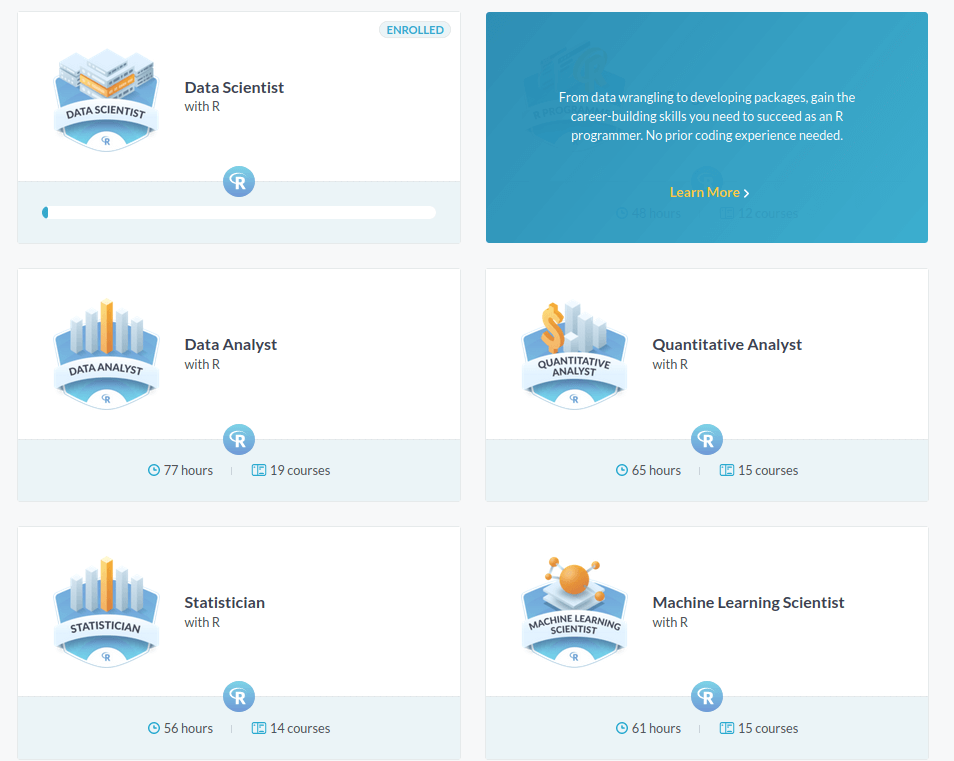
💡Did you know? R runs on all platforms – Windows, Mac and Linux.
DataCamp: Introduction to R Course
⚠️ Level: Beginner
⏰ Estimated completion time: 4 hours
💻 Exercises: 62
📹 Videos: 0 (atypical for this platform)
Introduction to R has 6 chapters:
- Intro to Basics
- Vectors
- Matrices
- Factors
- Data Frames
- Lists
Before the course begins, you’ll learn how to use the simple embedded code editor.
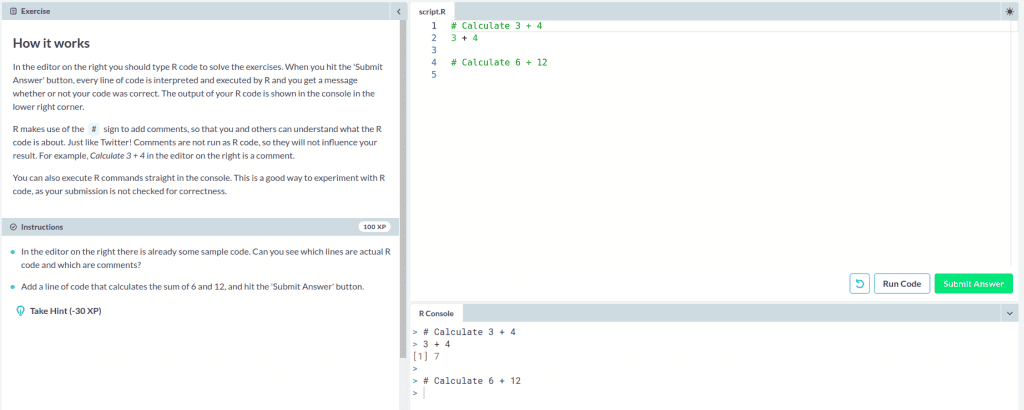
This lets you to code in the browser alongside the exercises.
This R basics course is also part of 3 skill and career tracks:
- Data Analyst with R
- Data Scientist with R
- R Programming
Let’s check it out.
✨ Chapter 1: Intro to Basics
In this chapter, you’ll learn how to use the console as a calculator and how to assign variables.
In addition, you’ll get to know the basic data types in R.
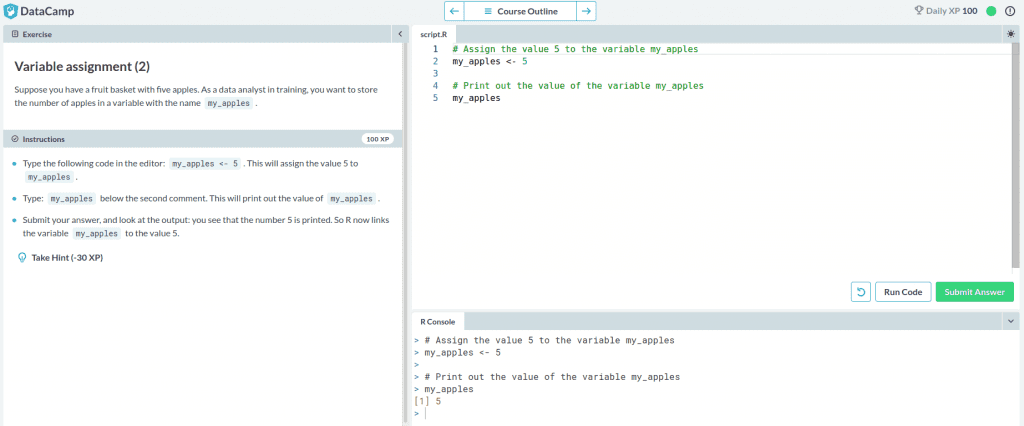
Plus you’ll work on 3 variable assignments using the embedded code editor.
✨ Chapter 2: Vectors
Things get a little spicy in this chapter: You’ll learn how to use vectors in R by analyzing Las Vegas gambling results. 🎰
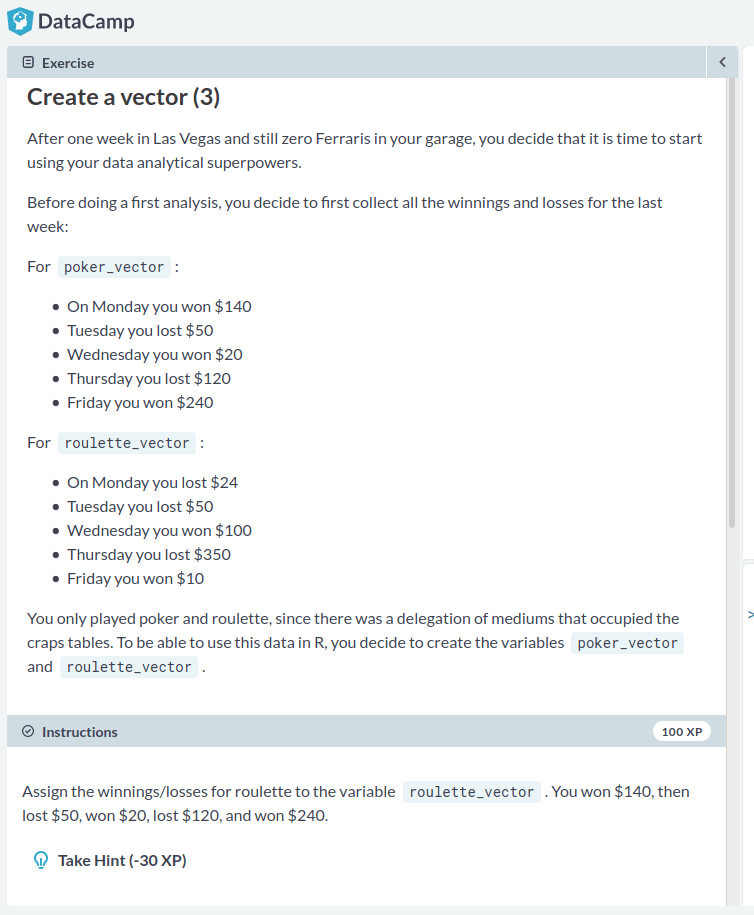
And from there you’ll be able to create vectors in R, name them, select elements, and compare different vectors.
✨ Chapter 3: Matrices
The fun keeps rolling on in this chapter: You get to analyze box office numbers of Star Wars movies.
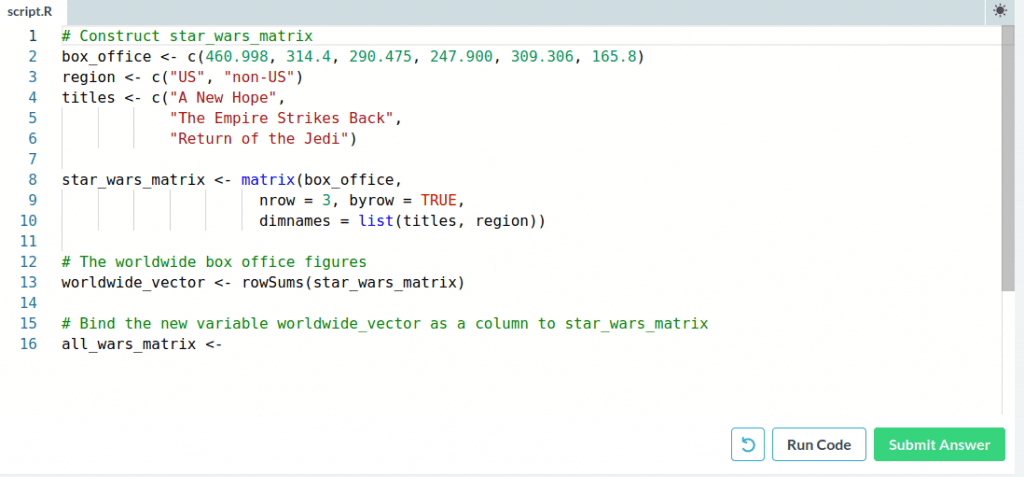
And learn how to use matrices in R, of course.
Upon completion, you’ll be able to create matrices and do basic computations with them.

✨ Chapter 4: Factors
This is the part of Introduction to R where things get a little more serious. No more Vegas. No more movies. It’s down to business…
Often times, data falls into limited numbers of categories.

And in this chapter, you’ll learn how categorical data is stored in factors. Then you’ll learn how to create, subset and compare factors using R.
✨ Chapter 5: Data Frames
Grab your space boots, because this chapter has a space theme. 🪐
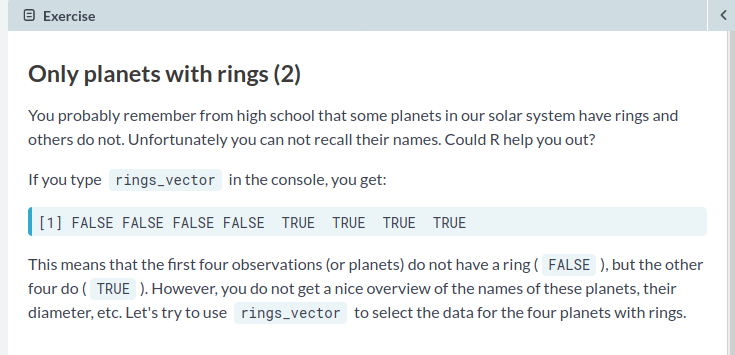
Most datasets are stored as data frames.
And by the end of this chapter, you’ll be able to create a data frame.
From there you can select interesting parts of and order a data frame according to certain variables.
✨ Chapter 6: Lists
Lists can hold components of different types.

Using Jack Nicholson’s movie career, you’ll learn how to create, name and subset lists.

Datacamp Pricing
Introduction to R’s first chapter is free on DataCamp.
However, you may want to consider a subscription for these perks:
| Free Tier | Monthly Subscription | Yearly Subscription 🤩 Best Deal! | |
| Cost | $0 | $25/mo | $33.25/mo |
| Access to Courses | First chapter only | All 340+ courses | All 340+ courses |
| Projects | 7 | 7 | 86 |
| All Coding Challenges | ✅ | ✅ | ✅ |
| Skill Assessment | 1 | Unlimited | Unlimited |
| Career Tracks | ❌ | 14 | 14 |
| Skill Tracks | ❌ | 51 | 51 |
| Mobile App Courses | ❌ | ✅ | ✅ |
| Community Chat | ❌ | ✅ | ✅ |
| Tableau, Power BI, Oracle | ❌ | ❌ | ✅ |
| Live Sessions | ❌ | ❌ | ✅ |
| Priority Support | ❌ | ❌ | ✅ |
👉 You can check out DataCamp here.
So, is Introduction to R Programming worth it? Conclusion
Whether you have previous coding experience or are a complete newbie, Introduction to R Programming on DataCamp is a high-quality beginner course to learn R.
It starts with the basics and hones in on the fundamentals.
And with DataCamp’s learning structure, you can easily transition into the next course, skill track or learning track.
So that way you can maximize your understanding of R programming.
Looking Ahead… Other DataCamp R Courses
Intermediate R Course
⚠️ Level: Intermediate
⏰ Estimated completion time: 6 hours
💻 Exercises: 81
📹 Videos: 14
After Introduction to R, you can jump right into DataCamp’s next course: Intermediate R.
Here you’ll learn about:
- conditional statements
- loops & functions
- regular expressions in R
- data structure manipulations
And much more.
More R Courses on DataCamp
And from there, you’ll get into more specified courses such as:
🔷 Introduction to Tidyverse
🔷 Correlation and Regression in R
🔷 Joining data with dyplr
🔷 Cleaning Data in R
🔷 Data Visualization in R
And many more.
Up Next: Is Grokking the Machine Learning Interview Worth It? [Machine Learning Interview Preparation]
What’s the best way to learn R programming?
DataCamp is one of the best platforms to learn R programming. There are almost 150 courses and 80 projects dedicated to R. Courses range from newbie to advanced. Plus there are skill tracks and career tracks that hone in on specific features.
What are some uses of R programming?
R is one of the most popular programming languages used by statisticians, data analysts, researchers and marketers. It’s used to retrieve, clean, analyze, visualize and present data. And it’s applied to varying fields such as social media, IT, finance, government, and more.
Is DataCamp Introduction to R worth it?
Yes, Introduction to R is worth it. Whether you have previous coding experience or are a complete newbie, Introduction to R Programming is a high-quality beginner course to learn R. It starts with the basics and hones in on the fundamentals. And with DataCamp’s learning structure, you can easily transition to the next course, skill track or learning track. So that way you can maximize your understanding of R programming.
